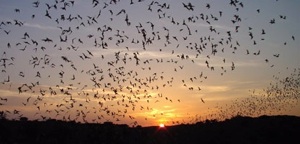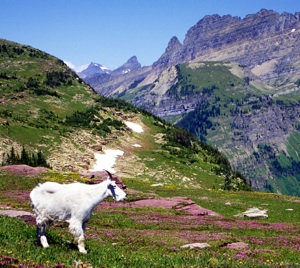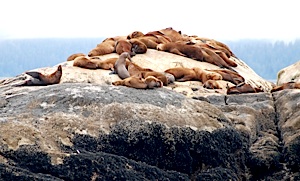Fifty years ago, human-influenced climate change was not seen as the threat to national parks that it poses today, urban pressures were not threatening to choke as many park units as they are today, and far fewer than 281 million visitors were traveling to the parks each year.
Indeed, when A. Starker Leopold and his colleagues reviewed wildlife management practices across the National Park System in 1963, they cited obvious problems, such as too many elk in Yellowstone and Grand Teton national parks. They noted the lack of science needed to drive management decisions, and they pointed out the obvious, that "habitat is not a fixed or stable entity that can be set aside and preserved behind a fence, like a cliff dwelling or a petrified tree."
But many of the issues and challenges confronting the National Park System today are different from those of the 1960s. So greatly have the factors influencing wildlife in the national parks changed over the past five decades that, in Park Service Director Jon Jarvis's mind, it's time to revisit the Leopold Report and update it for national parks in the 21st century.
For its day, the Leopold Report presented to Interior Secretary Stewart Udall clearly laid out the Park Service's role in wildlife management.

How best can the Park Service halt the spread of white-nose syndrome among bats in the parks, and protect those bats not yet infected? NPS photo from Carlsbad Caverns National Park.
Animals within the parks should not be allowed to overpopulate the parks and degrade their habitat; culling, and even hunting, should be utilized to control populations; and there was a need for a "greatly expanded research program, oriented to management needs..." within the park system.
To that end, Leopold and his colleagues addressed three broad questions:
1) What should be the goals of wildlife management in the national parks?
2) What general policies of management are best adapted to achieve the pre-determined goals?
3) What are some of the methods suitable for on-the-ground implementation of policies?
Some came to say some of the report's recommendations were overly romantic and idyllic, particularly as presented in the following passage:
"We would recommend that the biotic associations within each park be maintained, or where necessary recreated, as nearly as possible in the condition that prevailed when the area was first visited by the white man. A national park should represent a vignette of primitive America. (emphasis added)"
To their credit, the authors of the Leopold Report recognized how grandiose their vision might sound and realized there were limitations as to how far management could recover wildlife settings.
Restoring the primitive scene is not done easily nor can it be done completely. Some species are extinct. Given time, an eastern hardwood forest can be regrown to maturity but the chestnut will be missing and so will the roar of pigeon wings. The colorful drapanid finches are not to be heard again in the lowland forests of Hawaii, nor will the jack-hammer of the ivory-bill ring in southern swamps. The wolf and grizzly bear cannot readily be reintroduced into ranching communities, and the factor of human use of the parks is subject only to regulation, not elimination. Exotic plants, animals, and diseases are here to stay. All these limitations we fully realize. Yet, if the goal cannot be fully achieved it can be approached. A reasonable illusion of primitive America could be recreated, using the utmost in skill, judgment, and ecologic sensitivity. This in our opinion should be the objective of every national park and monument.
While that report long has served the Park Service in its approach to wildlife management, Director Jarvis, in his recent Call To Action, raised the need of updating the report to current management challenges.

How can the National Park Service help wildlife that would be affected by the disappearance of glaciers from national parks? Kurt Repanshek photo of mountain goat in Glacier National Park.
“The Leopold Report really was the seminal work, the foundation upon which we built our entire approach to the preservation and management, at least of the natural resources world," Mr. Jarvis told the Traveler during a recent interview. "Obviously, it’s 50 years old and it's time to revisit it."
While much of the Leopold Report remains relevant today, the director said, areas such as climate change and other human influences on the landscape -- how, for instance, the Park Service addresses vegetation, the arrival of non-native plants and species -- were not addressed by the Leopold team.
Some climate-change influences are greatly pressing on wildlife populations. Wolverines, which are dependent on snowfields, could be squeezed out of places such as Glacier National Park and North Cascades National Park as their snowfields vanish. Native fisheries -- both fresh water and salt water -- could be devastated by waters warmed by hotter summers. Vegetative changes across Alaska that result from a warming climate could pose problems for caribou.

Will a warming climate impact sea lions, such as these in Glacier Bay National Park? Kurt Repanshek photo.
The list goes on and on, touching on charismatic megafauna such as grizzly bears as well as birds.
Away from climate change, the lack of apex predators in parks such as Rocky Mountain, Wind Cave, Theodore Roosevelt, Valley Forge, and Gettysburg have pushed park managers to turn to hunting, culling, and even birth control in efforts to tamp down elk and deer populations.
To examine these and other 21st century influences on park wildlife and recommend revisions to the Leopold Report, Director Jarvis has assembled a distinguished team of outside experts:
* Dr. Rita Colwell (Committee Chair), Distinguished Professor at University of Maryland College Park and Johns Hopkins University Bloomberg School of Public Health; Chairman, Canon US Life Sciences, Inc., College Park, Maryland
Science Committee Members
* Dr. Susan Avery, President and Director at Woods Hole Oceanographic Institution, Woods Hole, Massachusetts
* Dr. Joel Berger, John J. Craighead Chair and Professor of Wildlife Conservation at University of Montana; Senior Scientist with the Wildlife Conservation Society, Missoula, Montana
* Dr. Daniel Botkin, Professor Emeritus in the Department of Ecology, Evolution, and Marine Biology at University of California Santa Barbara; President and Founder of The Center for the Study of the Environment; Professor of Biology at George Mason University, New York, New York
* Dr. Gary Davis, President of GE Davis & Associates, Westlake Village, California
* Dr. Healy Hamilton, Director of the Center for Biodiversity Research; Research Associate in the Department of Ornithology and Mammalogy at the California Academy of Sciences; Adjunct Assistant Professor in the Department of Geography and Human Environmental Sciences at San Francisco State University; Research Associate in the Department of Environmental Science, Policy, and Management at University of California Berkeley, San Francisco, California
* Dr. Thomas Lovejoy, Chief Biodiversity Advisor to the President of the World Bank; Senior Advisor to the President of the United Nations Foundation; President of the Heinz Center for Science, Economics, and the Environment, Washington, D.C.
* Dr. Shirley Malcom, Head of the Directorate for Education and Human Resources Programs of the American Academy for the Advancement of Science, Washington, D.C.
* Dr. Ann McMullen, Curator at the National Museum of the American Indian, Washington, D.C.
* Dr. Michael Novacek, Senior Vice President, Provost of Science, Curator at the American Museum of Natural History, New York, New York
* Dr. Elinor Ostrom, Distinguished Professor, Arthur F. Bentley Professor of Political Science, Senior Research Director of the Workshop in Political Theory and Policy Analysis at Indiana University; Founding Director of the Center for the Study of Institutional Diversity at Arizona State University; Professor in the School of Public and Environmental Affairs at Indiana University, Bloomington, Indiana
* Dr. Richard J. Roberts, Chief Scientific Officer at New England Biolabs, Ipswich, Massachusetts * Dr. Richard Tapia, Director of the Center for Excellence and Equity in Education; Associate Director for Minority Affairs in the Office of Graduate Studies, Director of Alliances for Graduate Education and the Professoriate, Maxfield and Oshman Professor in Engineering at Rice University; Adjunct Professor at University of Houston, Houston, Texas
The Park Service liaison to the team is Dr. Gary Machlis, the science advisor to Director Jarvis.
"They are working under the umbrella of the National Park System Science Advisory Board, so it is essentially advice to me, and the secretary of Interior, about the future of management of our national parks in light of these challenges," the director said.
With the growing challenges facing wildlife in the National Park System, their recommendations will be timely.


 Support Essential Coverage of Essential Places
Support Essential Coverage of Essential Places







Comments
This re-examination, re-thinking of the Leopold Report is a great Idea;
Thank You, Director Jon Jarvis; however, please consider the following:
A critical step toward implementing recommendations from this new cadre of "thinkers"re-examining the 50 year old Leopold Report is to make certain that key positions in parksare filled by truly qualified candidates. Often key Resource Management and Biologistpositions are filled & homesteaded with personalities who have little training or knowledge in criticaldisciplines. We're thinking of personalities at Redwood NP as one example, who wasted valuable timeand funds on the "1980's Composting Project" and later, Restoring Second-growth Forests whileignoring local & university scientists with superior knowledge on how to implement projects withpractical and appropriate protocols. These are the charlatan personalities in NaturalResource positions who call themselves scientists while having accomplished littlethemselves in any scientific field. Imagine the NPS charlatan scientists in the Oregon andWashington Cascadian National Parks denying that Asian blister rust was even present while ignoring good science that among five-needled pines, blister rust was prevalent.Several of the pioneering university scientists studying the ecological role of fire atSequoia-Kings NP were treated with disrespect by park superintendents with little interest in learning the values of prescribed fire since they had little interest in applied fire ecologicalnatural science. Critical to any revised Leopold Report recommendations and implementation is replacing unqualified resource managers calling themselves scientists with quality personnel having scientific integrity. The old solution of "what we need isanother generalist ranger" is nonsense today in an attempt to restore fragmented ecosystems. As long as charlatan natural resource chiefs and their apathetic weak superintendents remainin supervisory positions over qualified scientists, valuable time and funds will be poorly spent.